
The SX carriages were a type of passenger carriages constructed by Commonwealth Engineering for the Queensland Railways in 1961–1962.

The SX carriages were a type of passenger carriages constructed by Commonwealth Engineering for the Queensland Railways in 1961–1962.
The SX carriage stainless steel bodyshells were constructed by Commonwealth Engineering, Granville with the fitout undertaken at Rocklea in 1961/62. They were built to operate suburban services on the Brisbane rail network. [1] They shared many components with the New South Wales U set carriages. [2]
Initially hauled by steam and later diesel locomotives, provision was made for their conversion to electric multiple units once the network was electrified. Sixteen seven-carriage sets were completed. The conversion never occurred and they were gradually replaced from the 1980s as EMUs and SMUs entered service. [1] The last was withdrawn on 2 December 1999. [3]

To allow extra services to be operated during the 1987 America's Cup yacht regatta in Fremantle, 14 were leased to Transperth in October 1986. Initially intended as a short-term deal, they would remain in Perth until returned to Queensland in 1991. [4] [5] Others were exported to the Auckland Regional Council, [6] Ferrocarril de Antofagasta a Bolivia and State Railway of Thailand. [1] [7]
Seven SX carriages were imported to New Zealand in the early 2000s. A set of six were overhauled for the Auckland Regional Council. These were overhauled by the Hillside Workshops in 2002/2003, further refurbished in 2008/2009 and retired in 2014/15 as the AM class EMUs were introduced. SXA1744 was sold by Auckland Transport in its imported condition to Dunedin Railways and was used for storage. It was later on sold and is now privately owned and located near Bluff as of 2021. The six carriages in MAXX livery were stored in Taumarunui in the central North Island until sold for a dollar each to the Railway Enthusiasts Society. Five of the number consisted of AT MAXX set of SXV1697, SXC1741, SXC1742, SXC1743 and SXV1746. After a detailed inspection, they did not fulfil their needs and were advertised to Australian and New Zealand preservations groups. One was sold to Taumarunui Rail Action Centre Trust. [8] There was no further interest in the remaining five, so they were advertised on auction site TradeMe and were sold to private owners around New Zealand with bogies in March 2021 and were removed from Taumarunui on 17 June 2021. SXC1743 was relocated to Whanganui, SXC1742 went to Hastings and the remaining three carriages went to a single owner in Taupo. [9] [10] [11]
One set (7 cars) has been retained by Queensland Rail's Heritage Division [12] while others have been preserved including seven at the DownsSteam Tourist Railway & Museum, [13] another set in Cairns with Cairns Kuranda Steam Pty Ltd (stored in Cairns) and a set owned by Queensland University of Technology (stored at Ipswich).

The Mark 2 family of railway carriages are British Rail's second design of carriages. They were built by British Rail workshops between 1964 and 1975 and were of steel construction.

The North Island Main Trunk (NIMT) is the main railway line in the North Island of New Zealand, connecting the capital city Wellington with the country's largest city, Auckland. The line is 682 kilometres (424 mi) long, built to the New Zealand rail gauge of 1,067 mm and serves the large cities of Palmerston North and Hamilton.

The New Zealand EF class locomotive is a class of 25 kV 50 Hz AC electric locomotives that operate on the North Island Main Trunk (NIMT) between Palmerston North and Te Rapa in New Zealand. Built by Brush Traction in Loughborough, England between 1986 and 1988 to run on the new electrified central section of the NIMT, at 3,000 kilowatts (4,000 hp), they are the most powerful locomotives to operate in New Zealand.
Locomotives of New Zealand is a complete list of all locomotive classes that operate or have operated in New Zealand's railway network. It does not include locomotives used on bush tramways.
Transdev Auckland, formerly Veolia Transport Auckland, and Connex Auckland was a subsidiary of Transdev Australasia that ran Auckland's urban passenger trains under contract from Auckland Transport on infrastructure owned and managed by KiwiRail. Auckland Transport receives funding to subsidise these services from the NZ Transport Agency, which receives funding from road user taxes and Crown appropriations, and from the Auckland Council through rates.
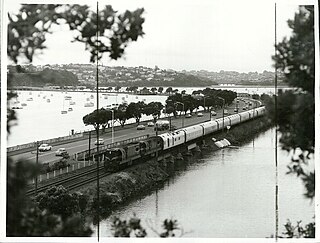
The Silver Star was a luxury passenger train that ran overnight between Auckland and Wellington on the North Island Main Trunk (NIMT) railway of New Zealand, operated by New Zealand Railways (NZR). The train ran from Monday 6 September 1971 until Sunday 8 June 1979. It replaced the Night Limited express passenger trains which provided a faster service than the ordinary express trains, by stopping at only six intermediate stations en route and not hauling a postal (sorting) van as on previous trains.
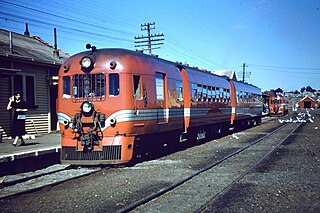
The NZR RM class 88-Seaters were a class of railcar used in New Zealand. New Zealand Government Railways (NZR) classified them as RM (Rail Motor), the notation used for all railcars, numbering the 35 sets from RM100 to RM134. They were the most numerous railcars in NZR service. Their purchase and introduction saw the demise of steam-hauled provincial passenger trains and mixed trains, and was part of a deliberate effort to modernise NZR passenger services at a time of increasing competition from private motor vehicles. Being diesel powered and lighter the railcars were less expensive to operate and able to maintain quicker timetables, although they became plagued with mechanical and electrical problems, with a number of the classes eventually being turned into depowered locomotive-hauled carriages and reclassified as the AC class "Grassgrubs".

UGL Rail is an Australian rail company specialising in building, maintaining and refurbishing diesel locomotives, diesel and electric multiple units and freight wagons. It is a subsidiary of UGL and is based in Melbourne, with a staff of 1,200 across Australia and Asia. It operates factories in Broadmeadow (Newcastle, Spotswood and Bassendean. While it used to operate a factory in Taree, the plant was shut down and the equipment sold off.
The Sunlander was a long distance passenger rail service operated by Queensland Rail on the North Coast line between Brisbane and Cairns in Queensland between June 1953 and December 2014. It has been replaced by the Spirit of Queensland.
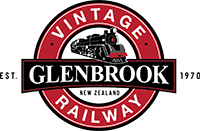
The Glenbrook Vintage Railway (GVR) is a heritage steam railway in Glenbrook, New Zealand.
This is a list of jargon commonly used by railfans and railway employees in New Zealand.
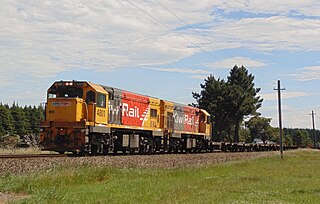
The New Zealand DC class locomotive is a type of diesel-electric mainline locomotive on the New Zealand rail network, operated by KiwiRail on freight trains, and formerly on long-distance passenger trains. The class was rebuilt from the DA class in the late 1970s and early 1980s, mainly in Australia. After the DA class, they were the most numerous class of diesel locomotive on New Zealand's railway network and remained numerically dominant until the mid-2010s when withdrawals began.
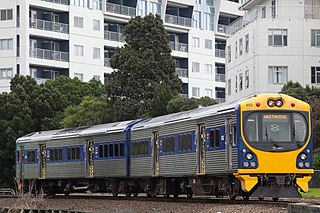
The ADL class is a class of diesel multiple units that were last operated by Auckland One Rail on the suburban rail network in Auckland, New Zealand. Originally built in the early 1980s by A Goninan & Co for Westrail of Western Australia, they were sold in 1993 by Westrail's successor, Transperth, to New Zealand Rail. The units are currently owned by Auckland Transport, and were withdrawn from service in August 2022 and transported to Glenbrook Vintage Railway and Pukeoware depot for storage.

The New Zealand DB class and DBR class locomotive is a type of diesel-electric locomotive built for service on New Zealand's rail network. They were built by General Motors Diesel (GMD) of Canada as a narrow-gauge version of the EMD G8 model, with seventeen locomotives constructed. Ten of these were later rebuilt into the DBR class.

The ADK class are a class of diesel multiple units that were previously operated by Western Australian Government Railways (WAGR) in Perth, and later Transdev Auckland on Auckland's suburban rail network, and are currently operated by MetroBus in Maputo, Mozambique. Originally built by Commonwealth Engineering and the Midland Railway Workshops for WAGR in the late 1960s, all but one were sold in 1993 to New Zealand Rail, and were then owned by Auckland Transport. The units were completely withdrawn from service in New Zealand on 5 December 2014, following completion of electrification of Auckland's network.
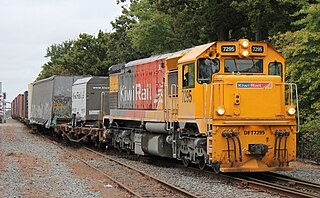
The New Zealand DF class locomotive of 1979 is a class of 30 Co-Co diesel-electric locomotives built by General Motors Diesel of Canada between 1979 and 1981. Between 1992 and 1997, all the locomotives were rebuilt as the DFT class, a turbocharged version of the DF.
The Northerner was an overnight passenger train between Wellington and Auckland in New Zealand. The train replaced the unnamed and ordinary express trains supplementing the luxury Silver Star, which had replaced the Night Limited in 1971. The Northerner operated from 1975 to 2004.

The NZR 56-foot carriage is a class of 56 ft (17 m) long railway passenger carriage formerly used on almost all long-distance passenger rail transport in New Zealand. 88 carriages have been preserved.

The New Zealand British Rail Mark 2 carriages were built by British Rail Engineering Limited for British Rail in the early 1970s. From the mid-1990s, 150 were exported to New Zealand. After being rebuilt, refurbished and re-gauged, they entered service with a variety of operators on New Zealand's railway network. The carriages generally replaced older NZR 56-foot carriages, some of which had been in use for almost 70 years.

The 2000 class railcars are a class of self-propelled railcars built by Commonwealth Engineering, Rocklea for the Queensland Railways between 1956 and 1971.